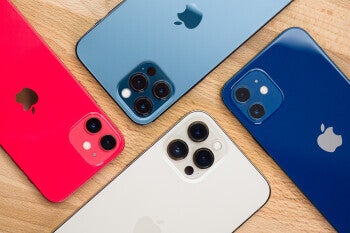Pricing for 5G iPhone 13 line could be impacted by higher chip prices, Samsung's price cuts and more

We could be just a tad more than a week away from the introduction of the iPhone 13 series. And if you want to know why we are calling the 2021 models the iPhone 13 and not the iPhone 12s, a photo that we showed you earlier in the day contains the answer. While many of the changes expected for the iPhone 13 series have been well-documented, perhaps the one metric discussed the least is the pricing of the new line.
Will Apple raise prices on the iPhone 13 series, keep prices the same, or reduce them?
According to Digitimes, TSMC is raising its pricing by as much as 20% on chips manufactured using "advanced and mature process technologies" by this coming January. Since that covers the 5nm A15 Bionic chip that will drive the iPhone 13 line, Apple might have to consider raising prices for the next iteration of the iPhone. After all, Apple isn't in the business of losing money every time an iPhone gets rung up.

Will Apple keep prices for the iPhone 13 series at iPhone 12 levels?
On the other hand, considering that the iPhone 12 series has been selling so well (not including the iPhone 12 mini), Apple might decide to keep the same pricing for the iPhone 13 series. And still another thing to consider is that Samsung dropped its pricing for the Galaxy S21 series and the Galaxy Z Fold 3 by $200. The Galaxy Z Flip 3 price fell by nearly $400 in 2021.
Could Samsung's actions put pressure on Apple to cut prices for the 2021 iPhone models? We'd have to say that this doesn't seem likely considering how well the 2020 iPhones are selling at current prices. Well, all except one specific model. More on that below. In the meantime, let's talk about changes coming to the iPhone 13 series. Perhaps the biggest change coming to the new iPhone models is the inclusion of the ProMotion screen which is expected to bring a 120Hz refresh rate to the iPhone 13 Pro and iPhone 13 Pro Max. This means that the display on those models updates 120 times per second allowing users to experience buttery smooth scrolling, enhanced animations and more.
Since a rapid refresh rate feature will drain your battery faster than normal, Apple will use LTPO backplane technology in order to make the refresh rate variable depending on the content that appears on the screen. Static content like texts and emails could drop the refresh rate down to as low as 1% saving battery life. On the other hand, video games will take advantage of the faster refresh rate in order to deliver a more fluid experience.
Apple could keep prices stable for all iPhone 13 models except for one
So here are the options Apple has. It could raise prices to cover the higher cost of procuring the A15 Bionic chip from TSMC (and adding the ProMotion display). As the foundry's largest customer, Apple might be able to avoid a drastic 20% price hike, but it might end up having to pay a bit more for the critical component and instead of taking the hit to its margins, it could decide to raise iPhone 13 prices.
Or, Apple could decide to price the iPhone 13 line at the same price it now charges for the iPhone 12. This actually makes sense considering how well the 2020 phones have been selling. And Samsung's price cuts make it harder for Apple to use the hike in chip prices as an excuse to raise prices. But what about Samsung's aforementioned price cuts? Doesn't Apple have to respond?
To check off all of the boxes, Apple could leave pricing the same for all models except for the iPhone 13 mini. This way Apple could continue to keep prices at a level that generates strong sales while still keeping margins high. Dropping the price on the iPhone 13 mini would give a boost to the one iPhone model that has been weak while still answering Samsung's price cut with one of its own.
Follow us on Google News










![A new Android bug is making it impossible to install new apps. Are you affected? [UPDATE]](https://m-cdn.phonearena.com/images/article/176703-wide-two_350/A-new-Android-bug-is-making-it-impossible-to-install-new-apps.-Are-you-affected-UPDATE.webp)

Things that are NOT allowed:
To help keep our community safe and free from spam, we apply temporary limits to newly created accounts: